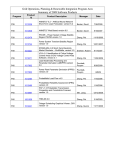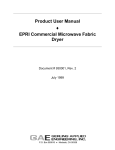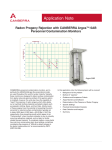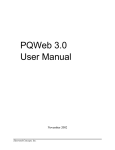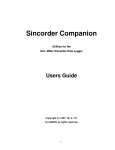Download Power System Analysis, Planning and Operations (PSAPO)
Transcript
Power System Analysis, Planning and Operations (PSAPO) Software Catalog Program Product Id Product Description Manager Date P40 1017802 Load Model Data Processing and Parameter Derivation (LMDPPD) Version 2.0 Pourbeik, Pouyan 26-Jun-09 P40 1017803 Power Plant Parameter Derivation (PPPD) Version 2.0 Pourbeik, Pouyan 6-Jun-09 P40.001 1015997 PCF v1.0 Probabilistic Transmission Congestion and Constraints Forecast, Version 1.0 Min, Liang 12-Dec-08 P39 1013743 On-Line Reliability Monitor with Visualization and Pattern Recognition Capacity Lee, Stephen 31-Dec-07 P39 1013744 Power System Transient Stability Region version 1.0 Zhang, Pei 31-Dec-07 P39 1014838 ANNSTLF Web Based Version 6.0 Becker, David 18-Sep-07 P39 1014531 STEMS-MS v3.0. Short-Term Electricity Market Simulator MultiSettle, Version 3.0 Robert Entriken 17-Sep-07 P40 1014441 Outage Scheduling Graphical Viewer, OSV Version 1.0 Zhang, Guorui 17-Nov-06 P39 1012479 PSVSR - Power System Voltage Stability Region PSVSR Version 1.0 Zhang, Pei 16-Nov-06 P40 1012484 Probabilistic Load Flow v4.0 Zhang, Pei 6-Nov-06 P40 1012485 Probabilistic Reliability Assessment (PRA) Version 4.0 Zhang, Pei 6-Nov-06 P39 1013336 ANNSTLF 5.1 - Artificial Neural Network Short-Term Load Forecaster, Version 5.1 Becker, David 31-May-06 P39 1013203 Transmission Outage Screening using Network Flow Model, Version 1.0 Zhang, Guorui 31-Mar-06 P40 1001629 TRELSS 6.0 Pei Zhang 18-Mar-03 Program P39 Product Id 1017802 Product Description Product Type Load Model Data Processing and Parameter Derivation (LMDPPD) Version 2.0 Manager Pourbeik, Pouyan Software Date 26-Jun-09 Intended End Users: System Planning Engineers Description/Impact: It is important to represent the dynamic behavior of system load for system planning studies and analysis. Developing load models is a challenging task due to the varying nature of loads and uncertainty in the load information. The Load Model Data Processing and Parameter Derivation (LMDPPD) Version 2.0 software tool is a simulation program that can be used for parameter estimation of the l-machine and 2-machine load model structures developed as part of EPRI’s load modeling efforts over the past several years. These two load models represent the aggregate response of the loads connected to the system under consideration. This software provides a tool for estimating the load model parameters using system disturbance data. This tool can estimate parameters and load composition for the following two load model structures: 1. 1-machine structure comprising of a static load model and an induction motor model to represent static and dynamic load characteristics respectively in the captured response 2. 2-machine structure comprising of a static load model and two induction motor models to represent dynamic loads in the captured response. The two induction motors allow representing large motors (for example fan motors, 3-phase industrial motors etc.) and small motors (e.g. residential air conditioners) separately. Platform Requirements: Windows XP or Vista (does not support Windows 2000) Implementation Resources Required: Resources and Other Costs: Staff Time (hours) Consultant Hardware Software Licensing Fee Training Maintenance and Support 20~40 hours to learn the software No consultant is needed to install the software No additional hardware is needed No additional software is needed 2009 members of Program 40 received a license since these programs funded the development of this tool. Others will have to license the program (go to www.epri.com and search for product ID 1017802 for license fee $15k). EPRI provides training for this software through service projects. This opportunity can be customized to meet an end-users’ specific needs. Please contact the service provider below. Maintenance is provided on an as needed basis. Travel N/A Delivered Through: EPRI (go to www.epri.com and enter the number “1017802” in the search option to download) Service Provider: Anish Gaikwad, [email protected], ph: 865-218-8066 Application Instructions: The software package includes a User Manual. The user manual provides clear instructions on how to use the software. The software package also includes a sample case. The user manual uses the sample case as the example to show users how to use the software step-by-step. EPRI suggests users take the time to run the sample case to obtain first-hand experience with theis software. Please contact Service Provider when users have any questions. Contact: Anish Gaikwad, [email protected], ph: 865-218-8066 Technology Transfer: Lora Cocco, 1-650-855-2620, [email protected] Deliverable Orders: 1-800-313-3774 (Option #2) or 1-650-855-2121, [email protected] Commercialization Strategy: There is no specific commercialization plan. Maintenance is provided on an as needed basis. Back to the Top of the Document Program Product ID Product Description Product Type Manager Date P40 1017803 Power Plant Parameter Derivation (PPPD) Version 2.0 Software Pourbeik, Pouyan 6-Jun-09 Intended End Users: The intended end user for this software tool is power system planners and/or power plant engineering staff. Knowledge of power plant modeling is required. Description/Impact: The Power Plant Parameter Derivation (PPPD) software tool is a simulation program that can be used for validation and parameter estimation of models for synchronous generators and their controls. This is a critical task and is currently mandated in the Western Electricity Coordinating Council (WECC) and soon to be mandated across the United States by the North American Electric Reliability Corporation (NERC). Based on WECC and imminent NERC standards, power plant models (for generators, their excitation systems, and turbine-governors) need to be validated periodically. This software tool offers a streamlined method for performing such model validation using one of two sources of data: 1. Data collected and measured from staged (typically, off-line) testing of the unit in the field 2. Digitally recorded ambient data from the unit while on-line, showing its response to naturally occurring system events (such as remote faults, loss of generation elsewhere on the system, and small frequency or voltage dips) The second method is typically the more effective and simpler way to achieve such model validation and saves significant costs by averting the need for staged field testing for revalidation of existing baseline models. Platform Requirements: IBM Compatible PC/Laptop with Windows XP or Vista (does not support Windows 2000). Implementation Resources Required: Resources and Other Costs: Staff Time (hours) Consultant 0 40 hours to learn how to use 0 Hardware No hardware beyond a personal computer is required. Software Licensing Fee Training Maintenance and Support Travel 0 2009 members of Program 40 and 65 received a license since these programs funded the development of this tool. Others will have to license the program (go to www.epri.com and search for product ID 1017803 for license fee $20k). Training is available through service contracts. Members needing training can contact the Service Provider (listed below) for more information. We are in the process of starting a User’s group for the purpose of maintenance and support for this software moving forward. Contact the service provider for more details. 0 Delivered Through: EPRI (go to www.epri.com and type “1017803” in the search option to download). Service Provider: Pouyan Pourbeik; 919-806-8126; [email protected] Application Instructions: The CD (or downloading from the EPRI website) includes a comprehensive manual that describes the program usage, installation and provides some tutorial examples. Contacts: Pouyan, Pourbeik, 919-806-8126; [email protected] Technology Transfer: Lora Cocco, 1-650-855-2620, [email protected] Deliverable Orders: 1-800-313-3774 (Option #2) or 1-650-855-2121, [email protected] Commercialization Strategy: Currently we are pursuing a User’s group to continue maintenance and upkeep of the software. Back to the Top of the Document Program P40 Product ID 1015997 Product Description PCF v1.0 Probabilistic Transmission Congetstion and Constratings Forecast, Version 1.0 Product Type Manager Date Software Min, Liang 12-Dec-08 Abstract The Probabilistic Transmission Congestion and Constraints Forecast (PCF) Version 1.0 program provides the user the capability to compute the probabilistic distribution functions of line flows with consideration of generation, load and network uncertainties. Description PCF Version 1.0 models the generation and load in a probabilistic way, and computes the probabilistic distribution functions of line flows. The program can handle generation and load uncertainties in a probabilistic model. It can handle transmission network in both deterministic and probabilistic ways. The PCF program also can display the overload information on the map of transmission network. It allows users to perform economic dispatch and user-defined dispatch during Monte Carlo simulation. Platform Requirements Windows™ 2000, XP, Vista Application, Value and Use PCF Version 1.0: • Provides more confidence in making judgments concerning alternative investments in transmission systems. • Enables greater utilization of current generation resources and increases potential for greater efficiencies. • Provides predictable and foreseeable bounded results instead of a "zero to perfect" one-time exercise. Delivered Through: EPRI (go to www.epri.com and type “105997” in the search option to download). Application Instructions: Contacts: Liang Min, 650-855-8705; [email protected] Technology Transfer: Lora Cocco, 1-650-855-2620, [email protected] Deliverable Orders: 1-800-313-3774 (Option #2) or 1-650-855-2121, [email protected] Back to the Top of the Document Program P39 Product Id 1013743 Product ID On-Line Reliability Monitor with Visualization and Pattern Recognition Capacity Manager Lee, Steve Activation Date 31-Dec-07 Intended End Users: Load Forecasting or System Planning Engineer; Power System Engineer; System Control Operator Description/Impact: Visualization and pattern recognition takes on a new direction with the advent of Phasor Measurement Units (PMU) being implemented and providing accurate real-time data at sampling rates up to about 30 per second. The challenge for system operators and planners is to visualize the real-time data in a way that can provide early warnings when certain precursor signals are detected, before cascading outages get out of control. EPRI has developed prototype software based on Matlab that will enable an engineer to visualize two variables in a twodimensional plot, called a phase-space diagram. A classical phase-space diagram is a plot of a generator’s rotor angle versus its frequency. When the plot is done over a time period of certain duration, the trace of these two variables on the two-dimensional graph would show distinct characteristics which differ for a stable generator and an unstable generator. A stable generator’s phase-space plot will show a more or less circular pattern with declining radius of rotation. An unstable generator’s phase-space plot will show a diverging path with increasing radius of rotation. A researcher hypothesis in this project is that when a suitable set of variables are plotted in the phase space, distinct patterns may be tell-tale signs that may be early warnings for potential cascading outages. In other words, they may be precursor signals of potential vulnerability to cascading outages. The purpose of this prototype software is to enable users to test this hypothesis on PMU data or other digital fault recorder data to experiment with the visualization of these data in the phase space. Results from these tests and experiments will be useful for extending this research direction into an on-line pattern recognition tool that provides early warnings of potential cascading outages. Platform Requirements: This prototype runs on an IBM compatible PC under the Windows 2000 or XP operating systems. Users must have the MatLab software in order to run this EPRI prototype software. Implementation Resources Required Resources and Other Costs Staff Time (hours) Consultant Hardware Software Licensing Fee Training Maintenance and Support Travel Delivered Through: Service Provider: * 1 hour to download; * 1 hour to learn (if users are experienced in MatLab); this includes ability to run the examples; * 20 – 40 hours to (if users are experienced in MatLab) to prepare utility specific parameter of data and then run it. Utility-specific data files can be run once and the results can be saved in order to do additional analysis. 0 0 Requires MatLab V6.5 or above Eligibility to download is based on EPRI membership. Non-funders may contact EPRI deliverable manager in this Plan to obtain price for license. Users needing assistance can call the EPRI Service Provider in this Plan. 0 0 Electronic Access; Service Provider or ‘Commercializer’ Kai Sun, EPRI. 650-855-2087. [email protected] Application Instructions: The prototype On-Line Reliability Monitor with Visualization and Patter Recognition Capacity should be used by any system planning engineer, or control room operator to visualize and experiment with the phase-space plots of PMU data. This prototype is provided as a download from EPRI.com. The download process is accessible for users who have an EPRIweb ID and password, and are funders of this project. User’s need only search on EPRIweb for Product ID # 1013743, and then click the “download” button. Downloading enables users to install the software on workstation(s). Once downloaded, users will open the “Read Me” file (ReadMe.txt) to understand how to use this software. Users must have MatLab (a commercial software program) in order to run this EPRI software. In addition, because this software runs in MatLab, EPRI recommends that users of this prototype software have some MatLab experience. In the Read Me file, users should pay particular attention to Section 2 Running the Program – where instructions are given on how to run the program and select parameters.- and Section 3 Data File Format Description – where information on how member specific data needs to be prepared to be accepted by this program. Users interested in viewing sample data should review Section 4. Introduction of Examples. In this section, users will copy the example (given in the Read Me file) directly into the MatLab Command Window. Users wishing to use the examples must make the current MatLab directory the same as where the actual software program is installed. To be successful at running this program using member specific data, EPRI suggests the following: • Users follow the Read Me file instructions closely • Users have an understanding of MatLab and how to write a command line in MatLab • Users clearly understand Section 3 in the Read Me file in order to import their own utility data This prototype runs on an IBM compatible PC under the Windows 2000 or XP operating systems. Users must have the MatLab software in order to run this EPRI prototype software. You can access MatLab at www.mathworks.com . The prototype software is designed to be easy to use. For those requiring additional assistance, EPRI is available to assist. Please contact the Service Provider (listed above in this Plan). This EPRI software provides users with information on their system dynamics and stability. Having this information allows users to understand their system better and use CAR (Community Activity Room – an EPRI complimentary product – EPRI PRODUCT #1010552 – delivered in year 2005) to visualize reliability problems and guide operators in the direction of improving system reliability. More information on CAR can be obtained from the EPRI website, or by contacting the Deliverable Manager listed in this Plan. Contacts: Deliverable Manager: Technology Transfer: Deliverable Orders: Stephen Lee, 650-855-2486, [email protected] Lora Cocco, 1-650-855-2620, [email protected] 1-800-313-3774 (Option #2) or 1-650-855-2121, [email protected] Commercialization Strategy: Please document a commercialization strategy in this section. I suggest we not just write to contact the Project Manager here. Back to the Top of the Document Program Product Id 39 1013744 Product Description Power System Transient Stability Region, version 1.0 Product Type Manager Date Software Zhang, Pei 31-Dec-07 Intended End Users Power System Engineer, System Operators, and System Planning Engineers Description/Impact Power System Transient Stability Region (PSTSR) is a software package developed based on security region concepts. Security of a power system refers to its robustness in relation to an imminent disturbance during operation. Security assessment is a key function in the system operation to help operators foresee the next critical contingencies that will cause system-wide stability problems. After deregulation, the power system has also experienced an increasing diversity of transactions. The new power flow patterns and magnitudes have added significant and unpredictable complexity to the power delivery system in a way that the system was not designed to handle. Therefore, it is critical to bring security assessment in operation environment. Security region concepts provide a promising framework for on-line security monitoring and control. Different from traditional "point-wise" approach, security region concepts can give power system engineers systematic and global information about a feasible operation region Power System Transient Stability Region (PSTSR) is a tool to help system operators and planners understand the operating boundaries composed by transient stability constraints. PSTSR allows system engineers to: • Determine whether an operating point is secure by judging if it lies within the security region. • Determine the stability margin by calculating the distance between the operating point and the boundary of security region. • Decide the most effective control strategies to enhance system security margin. Platform Requirements Windows 2000 or XP Implementation Resources Required: Resources and Other Costs: * Less than 1 hour to download the software Staff Time (hours) Consultant Hardware Software Licensing Fee Training Maintenance and Support Travel * 20~40 hours to learn the software No consultant is needed. No additional hardware is required No additional software is required Eligibility to download is based on EPRI membership. Software is pre-paid for EPRI funders of this product. Non-funders wishing to purchase this product have a license fee of $15K per copy. EPRI provides training for this software through supplemental project opportunities. This opportunity can be customized to meet an end-users’ specific needs. Generally customized training ranges from $10K to $20K. Please contact the Service Provider (listed below) to obtain additional information on training. $10K for annual support and maintenance cost provided by EPRI through supplemental project opportunities. The annual support and maintenance includes: • Support for Installation • Support for Maintenance • User Group Meeting N/A Delivered Through: Webcast, Workshop or Training Course Service Provider: Pei Zhang, 650-855-2244, [email protected] Technology Transfer: Lora Cocco, 1-650-855-2620, [email protected] Deliverable Orders: 1-800-313-3774 (Option #2) or 1-650-855-2121, [email protected] Application Instructions: Funders of this product can download the software from EPRI.com. The download process is accessible for users who have an EPRIweb ID and password. User’s need only search on EPRIweb for Product ID # 1013744, and then click the “download” button. The software can also be ordered from EPRI Software Distribution Center. The software package includes a User Manual. The user manual provides clear instructions on how to use the software. The software package also includes a sample case. The user manual uses the sample case as the example to show users how to use the software step-by-step. EPRI suggests users take the time to run the sample case to obtain first-hand experience with theis software. Please contact Service Provider when users have any questions. Contacts: Pei Zhang, 1-650-855-2244, [email protected] Deliverable Orders: 1-800-313-3774 (Option #2) or 1-650-855-2121, [email protected] Commercialization Strategy: EPRI plans to work with vendors to commercialize the software in the next 2~3 years. The software still needs improvements and validation before commercialization. Currently, EPRI is providing support through supplemental project opportunities. After commericialization, the commercializer will provide support and maintenance service. Back to the Top of the Document Product Id Program P39 1014838 Product Description Product Type ANNSTLF Web Based Version 6.0 Software Manager Becker, David Date 18-Sep-07 Intended End Users: This section needs to be identified – using the “Intended User’s” List from SPPS. Description/Impact: The Electric Power Research Institute's (EPRI) Artificial Neural Network Short-Term Load Forecaster (ANNSTLF) Version 6.0 software is a Windows-based neural-network load forecaster that uses historical load and weather parameters to predict future load values. It also has a neural-network-based hourly temperature forecaster, an hourly humidity forecaster, and several data and performance analysis tools. ANNSTLF 6.0 allows electric power utilities – both domestic and international – the opportunity to complete short-term load forecasting with the ability to forecast system loads up to 35 days in advance. WebANNSTLF 6.0 is a web client-server system for short-term load forecasting applications based on the latest neural networks technology with a wealth of customer experience and inputs. Background: WebANNSTLF 6.0 is an upgrade and enhancement of the desktop ANNSTLF 5.1, aimed at substantially increasing the usability of the ANNSTLF forecaster within the corporate enterprise. WebANNSTLF provides hourly load forecasts for a region or territory from 2 to 35 days into the future, based on historical load and weather data, as well as weather forecasts. [This should go in the Description and the Impact Section of this software template (just above)]Benefits and value provided by the WebANNSTLF 6.0 software include: • Very accurate short-term load forecasts with reasonable amounts of input data • Easy automation at a utility environment using web services and SQL database • Information within the enterprise system for any number of users with different authority levels – all via a standard web browser Platform Requirements: The following hardware and software are required: • Windows XP, Windows 2000, and Windows Server 2003 • Java 2 1.5 or higher, Internet Explorer 7.0 or higher or Mozilla Firefox 2.0 or higher on client (independent of operating system) This Client-Sever software is designed to run as follows: (a) Both client and server can reside on one's PC, and hence run like a standalone desktop application, or (b) With the server computer, separate from the client computer within the corporate environment of a customer, thus allowing many users the access it. The administration system provides the required security and authority user levels, or (c) With the server computer available through a commercial vendor, whereby many corporate client users can still use it with the same security and authority levels provided in (b) above. This multi-user software is designed to reside on a computer (such as a server) where it is accessed by multiple-users from other computers. It may also be installed and run on a single user computer. Users should consult with their IT departments for help with installation. Implementation Resources Required: Resources and Other Costs: Staff Time (hours) Consultant Hardware Software Licensing Fee Training Minimal-provide initial 3 yr history data [need information on the number of staff hours that are required to 1) understand this product and 2) regularly use it. None All modern CPU’s - No hardware beyond a personal computer is required. nique to specific utility and number of regions Unique to specific utility and number of regions. Unique to specific utility and number of regions Maintenance and Support Travel Unique to specific utility and number of regions None Delivered Through: Electronic Access; Service Provider or ‘Commercializer’ Service Provider:David Becker,[email protected] Application Instructions: Receive and install with electronic files. Support provided by phone.. Contacts: David Becker, 650/855-2307, [email protected] Back to the Top of the Document Program Product Id 39 1014531 Product Description STEMS-MS v3.0. Short-Term Electricity Market Simulator MultiSettle, Version 3.0 Product Type Manager Date Software Robert Entriken 17-Sept-07 Intended End Users: • Billing & Settlement; • Capital Projects Staff; • Demand-Side Mgmt./Load Mgmt./Conservation; • Distributed Generation Staff • Economic Development; • Energy Efficiency Staff; • Federal Governmental/Regulatory Agencies; • Gas, Oil & Petroleum Industries; • Governmental and Regulatory Affairs Staff • Load Forecasting or System Planning Engineer; • Local/Regional Governmental/Regulatory Agencies; • New Business/Product Development; • Operations & Maintenance; • Pricing; Procurement Engineer; • Public Benefit; • Retail & Wholesale Power Markets; • Retail Energy Services; • Strategic R&D (for End-use, New Technologies, and Customer Interface) Staff; • Strategy/Planning; Description/Impact: The Short-Term Electricity Market Simulator – MultiSettle (STEMS-MS), Version 3.0 software allows the user to simulate flexibly examples of electricity markets. It can also be used to investigate long-term incentives for investment using an integrated planning perspective. STEMS-MS is based on EPRI's pioneering development and application of agent-based simulation for the study of decision-making associated with electricity markets. A recent Nobel Prize in Economics was awarded to earlier pioneers of this type of investigation using human subjects, which is called experimental economics. While the use of computerbased agents to simulate decision making associated with electricity markets is relatively new, others have used individuals in similar experiments for some time. EPRI’s goal is to improve the ability to predict actual market behavior through the use of software that mimics human decision-making processes. STEMS-MS is also available through customized analytical services by EPRI. Platform Requirements: The following hardware and software are required: • • • Windows 2000 or Windows XP System Memory: 300 MB, 600 MB recommended. Hard Disk Space: 20 MB Java 1.4 and compatible versions Implementation Resources Required: Resources and Other Costs: • • Staff Time (hours) Consultant 30 minutes to download; 1 hour to learn (if users are experienced in markets); this includes ability to run the examples; • 20 – 40 hours to (if users are experienced in power system modeling and markets) to prepare utility specific parameter data and then run it. Utility-specific data files can be run once and the results can be saved in order to do additional analysis. Consultants are available at a cost of about 100 $/hr to assist in implementing market and investment models. A typical customized model will cost about $10,000 to set up. Hardware Software Licensing Fee Training Maintenance and Support Travel No hardware beyond a personal computer is required. Requires Java V1.4 and compatible versions, CBC solver DLL from separate on-line download. Having an XML editor can be helpful, but a text editor works as well. Eligibility to download is based on EPRI membership. Nonfunders may contact EPRI deliverable manager in this Plan to obtain price for license. {note the EPRI system has this software priced at $15,000 for non-funders; I suggest we include the price in this section.} 1) EPRI provides training for this software through supplemental project opportunities. This opportunity can be customized to meet end-users specific needs. Generally customized training ranges from $15,000 to $20,000. 2) EPRI offers regional training courses once a year. Information on training courses can be found at ww.epri.com (event calendars for Power Delivery and Utilization). Regional training has a current price of about $3,000 for non-members and a reduced priced for members, depending also on the location and the length of the course. Users needing assistance can call the EPRI Customer Assistance Center (CAC). Maintenance and support is currently available through contractors. Contact EPRI (CAC) for a quote, depending on the extent of need. Trips to training cost about $1,000 to $2,000, depending on the location and duration of the visit. Delivered Through: Electronic Access; Service Provider or ‘Commercializer’, Webcast, Workshop or Training Course. Service Provider: Robert Entriken; 650/855-2665; [email protected] Application Instructions: The software is accessed through EPRI’s web site, where it can be downloaded for installation on a personal computer. To learn how to use the software, first follow the accompanying instructions for a tutorial on how to navigate the application and to run demonstration market simulations. More detailed information on how to set up your own market simulation is available within the demonstration XML files. Here you can find detailed comments on the meaning and use of the input parameters and access examples of how to set up and run numerous different simulation schemes. Technical background for these simulations can be found in a number of EPRI reports that give full documentation [1, 2, and 3] on how the market models were set up and what the results mean. The application does not have on-line help, but it has extensive and action-oriented error messages that appear in dialog messages and the system console. Use of the system console gives a full record of application progress. Having an XML editor or syntax checker is useful to avoid error messages. If questions arise, be prepared to provide a copy of your input file and a copy of the console record of the run. This will help us to understand precisely what the problem is and how to rectify it. [1] Agent-Based Simulation of the Automatic Mitigation Procedure, EPRI, Palo Alto, CA, California Energy Commission, Sacramento, CA, and Lawrence Berkeley National Laboratory, Berkeley, CA: 2003. 1007733. http://www.epriweb.com/public/000000000001007733.pdf [2] Pushing Capacity Payments Forward: Agent-Based Simulation of an Available Capacity, EPRI, Palo Alto, CA, California Energy Commission, Sacramento, CA, and Lawrence Berkeley National Laboratory, Berkeley, CA: 2003. 1007755. http://www.epriweb.com/public/000000000001007755.pdf [3] Transmission Investment Incentives: Economic Analysis by Example. EPRI, Palo Alto, CA: 2006. 1012489. Contacts: Support is provided by the Project Manager, and paid for by the users. Please contact Robert Entriken. Commercialization Strategy: This software was developed and used in a number of customized analyses of market designs before they were implemented. It is also useful for understanding the strategic incentives of investors and market participants. EPRI’s intent is to make this software available with an open source agreement. In this way, the widest possible distribution and use of these techniques can be achieved. Back to the Top of the Document Program P39.008 Product Id 1014441 Product Description Outage Scheduling Graphical Viewer, OSV Version 1.0 Product Type Software Manager Zhang,Guorui Date 17-Nov-06 Intended End Users: Transmission outage scheduling engineers, coordinators or managers Generator outage scheduling engineers and coordinators or managers Description/Impact: A web based outage scheduler viewer that can assist utilities in performing and coordinating the outage scheduling for each utility or Independent System Operator (ISO) or multiple control areas or multiple reliability regions. The outage scheduler viewer can display generator, transmission line and transformer outages along with the load forecast and reliability index calculation. The outage schedule viewer is developed using Service Oriented Architecture (SOA) and using advanced outage schedule database. The users can access the OSV application via the Internet or intranet. The OSV application can easily be configured according to the user’s requirements and practices for performing outage scheduling and coordination. A workflow process is implemented in the OSV application to facilitate the preparation, submittal, review, approval and auditing of the outage requests. The web based Outage Scheduling Viewer and editor (OSV), Version 1.0 software consists of the following main modules: • Relational outage scheduler database using Oracle 9i or Oracle 10G database • Outage scheduler viewer and editor using Gantt chart for user to submit, review, update, reject or approve outages requests based on the assignment of user’s authorities and roles. • Outage scheduler configuration for OSV administrator to set up the following OSV application parameters: User name and password Configuration parameters User roles and security Workflow process parameters Voltage color scheme • The web based OSV application allow the user to: • Shows outage schedules using scrollable Gantt chart on monthly, weekly and hourly schedules • Display outage schedules on a company basis, control area basis, zone basis, system basis, on facility type (generators, lines, transformers, tie-line) basis or on voltage level basis • Display certain transmission lines such as tie-lines and flowgate elements using special indication • Add new schedules into the chart or update the existing outage schedules. • Stretch, move and shorten the Gantt chart graphical objects to adjust the schedules • Show transmission or generator outages using different colors according to voltage levels • Show transmission or generator outages using different sizes of Gantt chart according transmission or generation cpacity. • Show the processing status of each outage • Incorporate workflow process • Facilitate the user to create, review, update, submit, deny or approve outages. • Show generation/transmission reliability indices • Import/export outage schedules in NERC's System Data Exchange (SDX) format Platform Requirements: At lease one computer server is needed to install the application including database and web server with the following system requirements: Windows 2000 or Windows 2003 server 40 GB hard disk 1.5 GB RAM Oracle database server 9i J2EE web server in compliance with J2EE 1.5 ActivePerl 5.86.811 Implementation Resources Required: Resources and Other Costs: 0 Staff Time (hours) 40 to 60 hours to prepare the input data, attending the training and to perform the initial testing Consultant 0 Hardware 2,000 to 4,000 USD – A high end workstation or computer server is required. Software Oracle 9i Database software. Licensing Fee Please contact Dr. Jing of Emit at 612-810-8042 for the license fee. The EPRI funders of this product will not need to pay the license fee. Nonfunders wishing to purchase this product can contact Emit for the license fee. Training The training of two days (16 hours) will be held at the customer’s site and will be provided by Emit. This training is included when you purchase the SOV software. Maintenance and Support Free for the firstyear. The cost of the maintenance and technical support after the first year will 20% of the purchasing cost. Travel No travel is required by customer. Delivered Through: Training course and technical services via EMIT (EPRI OSV Commercializer). Service Provider: EMIT (EPRI OSV Commercializer). Chaoyang Jing 612-810-8042, [email protected] Application, Instructions: The EPRI OSV software is marketed by Emit which is the commercializer of this software. Please contact Dr. Jing of Emit at 612-810-8042 if you are interested in this EPRI OSV Contact: Deliverable Manager: Guorui Zhang, 650-2248, [email protected] Chaoyang Jing 612-810-8042, [email protected] Technology Transfer: Lora Cocco, 1-650-855-2620, [email protected] Deliverable Orders: 1-800-313-3774 (Option #2) or 1-650-855-2121, [email protected] Commercialization Strategy: The current developer and commercializer is EMIT. EMIT will help the users who purchase this EPRI OSV software to install the software, provide the required training to to provide the required technical support. Back to the Top of the Document Program Product Id P39 1012479 Product ID Manager Activation Date PSVSR - Power System Voltage Stability Region PSVSR Version 1.0 Zhang, Pei 16-Nov-06 Intended End Users: Power System Engineers, System Operations, System Planning Engineers Description/Impact: Power System Voltage Stability Region (PSVSR) v1 is a software package that calculates the voltage stability region based on the security region concepts. New power flow patterns and magnitudes have added significant and unpredictable complexity to the power delivery system in such a way that the system was not designed to handle. Therefore, it is critical to bring security assessment in operation environment. Security region concepts provide a promising framework for on-line security monitoring and control. PSVSR Version 1.0 software is a tool to help system operators and planners to understand the operating boundaries composed by voltage stability constraints. PSVSR can help power system engineers • Determine whether an operating point is secure by judging if it lies within the security region. • Determine the stability margin by calculating the distance between the operating point and the boundary of security region. • Decide the most effective control strategies to enhance system security margin. Platform Requirements Windows 2000 or Windows XP Implementation Resources Required: Resources and Other Costs: Staff Time (hours) * Less than 1 hour to download the software * 20~40 hours to learn the software Consultant No consultant is needed to install the software Hardware No additional hardware is needed Software No additional software is needed Licensing Fee Training Maintenance and Support Travel Eligibility to download is based on EPRI membership. Software is pre-paid for EPRI funders of this product. Non-funders wishing to purchase this product have a license fee of $10K per copy EPRI provides training for this software through supplemental project opportunities. This opportunity can be customized to meet an endusers’ specific needs. Generally customized training ranges from $10K to $20K $10K for annual support and maintenance cost provided by EPRI through supplemental project opportunities. The annual support and maintenance includes • Support for Installation • Support for Maintenance • User Group Meeting N/A Delivered Through: Webcasts and Training Workshops Service Provide: Pei Zhang 650-855-2244, [email protected] Application Instructions: Funders of this product can download the software from EPRI.com. The download process is accessible for users who have an EPRIweb ID and password. User’s need only search on EPRIweb for Product ID # 1012479, and then click the “download” button. The software can also be ordered from EPRI Software Distribution Center. The software package includes a User Manual. The user manual provides clear instructions on how to use the software. The software package also includes a sample case. The user manual uses the sample case as the example to show users how to use the software step-by-step. EPRI suggests users take the time to run the sample case to obtain first-hand experience with theis software. Please contact Service Provider when users have any questions. Contact: Deliverable Manager: Pei Zhang, 650-2244, [email protected] Technology Transfer: Lora Cocco, 1-650-855-2620, [email protected] Deliverable Orders: 1-800-313-3774 (Option #2) or 1-650-855-2121, [email protected] Commercialization Strategy: EPRI plans to work with vendors to commercialize the software in the next 2~3 years. The software still needs improvements and validation before commercialization. Currently, EPRI is providing support through supplemental project opportunities. After commericialization, the commercializer will provide support and maintenance service. Back to the Top of the Document Program P39 Product Id Product Description 1012484 Probabilistic Load Flow v4.0 Product Type Software Manager Zhang, Pei Date 6-Nov-06 Intended End Users: Power System Engineers and System Planning Engineers Description/Impact: The computation of power flows in the electric power system is one of the major tasks facing power system planners. Deterministic load flow study requires specific values for loads, generations inputs, and network conditions. In an open access environment, this information is less certain than in a vertically integrated system. In system planning, it is desirable to assess bus voltages and line flows for a range of load and generation conditions. To carry out conventional load flow computations for every possible or probable combination of busloads and generating unit outages is impractical because of the extremely large computational effort required. Probabilistic Load Flow, Version 4.0 software provides system planning engineers more information on potential future system conditions and provides more confidence in making judgments concerning investment in the power system. Platform Requirements: Windows 2000 or Windows XP. Implementation Resources Required: Resources and Other Costs: Staff Time (hours) * Less than 1 hour to download the software * 20~40 hours to learn the software Consultant Hardware Software No consultant is needed to install the software Licensing Fee Training Maintenance and Support Travel No additional hardware is needed No additional software is needed Eligibility to download is based on EPRI membership. Software is pre-paid for EPRI funders of this product. Non-funders wishing to purchase this product have a license fee of $10K per copy. EPRI provides training for this software through supplemental project opportunities. This opportunity can be customized to meet an endusers’ specific needs. Generally customized training ranges from $10K to $20K $10K for annual support and maintenance cost provided by EPRI through supplemental project opportunities. The annual support and maintenance includes • Support for Installation • Support for Maintenance • User Group Meeting N/A Delivered Through: Webcasts and Training Workshops Service Provide: Pei Zhang 650-855-2244, [email protected] Application Instructions Funders of this product can download the software from EPRI.com. The download process is accessible for users who have an EPRIweb ID and password. User’s need only search on EPRIweb for Product ID # 1012484, and then click the “download” button. The software can also be ordered from EPRI Software Distribution Center. Deliverable Orders: 1-800-313-3774 (Option #2) or 1-650-855-2121, [email protected] The software package includes a User Manual. The user manual provides clear instructions on how to use the software. The software package also includes a sample case. The user manual uses the sample case as the example to show users how to use the software step-by-step. EPRI suggests users take the time to run the sample case to obtain first-hand experience with theis software. Please contact Service Provider when users have any questions. Contact: Deliverable Manager: Pei Zhang, 650-2244, [email protected] Technology Transfer: Lora Cocco, 1-650-855-2620, [email protected] Deliverable Orders: 1-800-313-3774 (Option #2) or 1-650-855-2121, [email protected] Commercialization Strategy: EPRI plans to work with vendors to commercialize the software in the next 2~3 years. The software still needs improvements and validation before commercialization. Currently, EPRI is providing support through supplemental project opportunities. After commericialization, the commercializer will provide support and maintenance service Back to the Top of the Document t Program P39 Product Id 1012485 Product Description Product Type Probabilistic Reliability Assessment (PRA) Version 4.0 Software Manager Zhang, Pei Date 6-Nov-06 Intended End Users: Power System Engineers and System Planning Engineers Description/Impact: Probabilistic Reliability Assessment (PRA) is a methodology that provides the capability for determining the probability or likelihood of an undesirable event on the transmission system and a measure of its severity. PRA combines a probabilistic measure of the likelihood of undesirable events with a measure of the consequence of the events into a single reliability index—Probabilistic Reliability Index (PRI). Probabilistic Reliability Assessment (PRA v4.0) software reads load flow text files as well as probabilistic information and then computes and displays reliability indices through a Graphical User Interface. Platform Requirements: • Windows 2000 or Windows XP Implementation Resources Required: Resources and Other Costs: Staff Time (hours) * Less than 1 hour to download the software * 20~40 hours to learn the software Consultant Hardware Software No consultant is needed to install the software Licensing Fee Training Maintenance and Support No additional hardware is needed No additional software is needed Eligibility to download is based on EPRI membership. Software is pre-paid for EPRI funders of this product. Non-funders wishing to purchase this product have a license fee of $15K per copy. EPRI provides training for this software through supplemental project opportunities. This opportunity can be customized to meet an endusers’ specific needs. Generally customized training ranges from $10K to $20K $10K for annual support and maintenance cost provided by EPRI through supplemental project opportunities. The annual support and maintenance includes • Support for Installation • Support for Maintenance • User Group Meeting Travel N/A Delivered Through: Webcasts and Training Workshops Service Provider: Pei Zhang 650-855-2244, [email protected] Application Instructions: Funders of this product can download the software from EPRI.com. The download process is accessible for users who have an EPRIweb ID and password. User’s need only search on EPRIweb for Product ID # 1012485, and then click the “download” button. The software can also be ordered from EPRI Software Distribution Center. The software package includes a User Manual. The user manual provides clear instructions on how to use the software. The software package also includes a sample case. The user manual uses the sample case as the example to show users how to use the software step-by-step. EPRI suggests users take the time to run the sample case to obtain first-hand experience with theis software. Please contact Service Provider when users have any questions. Contact: Deliverable Manager: Pei Zhang, 650-2244, [email protected] Technology Transfer: Lora Cocco, 1-650-855-2620, [email protected] Deliverable Orders: 1-800-313-3774 (Option #2) or 1-650-855-2121, [email protected] Commercialization Strategy: EPRI plans to work with vendors to commercialize the software in the next 2~3 years. The software still needs improvements and validation before commercialization. Currently, EPRI is providing support through supplemental project opportunities. After commericialization, the commercializer will provide support and maintenance service. Back to the Top of the Document Program P39 Product Id 1013336 Product Description ANNSTLF 5.1 - Artificial Neural Network Short-Term Load Forecaster, Version 5.1 Product Type Software Manager Date Becker, David 31-May-06 Intended End Users: [ Need the “Intended End Users” from the list in SPPS.] Description/Impact: The Electric Power Research Institute's (EPRI) Artificial Neural Network Short-Term Load Forecaster (ANNSTLF) Version 5.1 software is a Windows-based neural-network load forecaster that uses historical load and weather parameters to predict future load values. It also has a neural-network-based hourly temperature forecaster, an hourly humidity forecaster, and several data and performance analysis tools. ANNSTLF 5.1 allows electric power utilities – both domestic and international – the opportunity to complete short-term load forecasting with the ability to forecast system loads up to 35 days in advance. Background Application of the artificial neural network technology for forecasting in power systems has received much attention in recent years. EPRI's technology is highly regarded due to its ability to learn complex and non-linear relationships, which are difficult to model with conventional techniques. ANNSTLF 5.1 provides self training every day it is used. A neural network can provide accurate results even for input samples, which are quite different from learning samples. That capability enables the artificial neural-network-based system to model the correlations between the electricity load, factors such as temperature and other climatic conditions, time and type of day effect, and season effect. This capability makes ANNSTLF 5.1 very suitable for building a generic shortterm load forecasting model. The ANNSTLF 5.1 software features a number of enhancements that were requested by the ANNSTLF User Group. ANNSTLF is driven by a strong user group who are funding yearly members. ANNSTLF Users have prioritized the enhancements desired. The ANNSTLF 5.1 software can operate as either a standalone or networked application. Platform Requirements: The following hardware and software are required: Windows 2000/XP Users of ANNSTLF 5.1 find the ability to run the software to be very flexible. The software can be run on an individual computer, multiple user computers, and synchronized periodically. ANNSTLF 5.1 can also be operated on a server in a networked configuration. The ANNSTLF 5.1 software can be installed and run on systems utilizing Windows NT 4.0, 98, and 95, but those platforms are not supported. Users assume own risk when installing ANNSTLF 5.1 onto systems utilizing Windows NT 4.0, 95, or 98. Implementation Resources Required: Resources and Other Costs: Staff Time (hours) Consultant Hardware Software Licensing Fee Training Minimal-provide initial 3 yr history data [need information on the number of staff hours that are required to 1) understand this product and 2) regularly use it. None No hardware beyond a personal computer is required. EPRI ANNSTLF Neural Net Software Provided $26K min purchase – Non-member minimum cost is $32K for 1 region. This cost of $26K/$32K gets 1 region fully trained with one year of support Optional 2 day on site available Maintenance and Support Travel $10K/year full support – Included in first year of purchase and for each subsequent year. Phone Phone and electronic support available to meet all problems None Delivered Through: . Service Provider:David Becker,[email protected]; Application Instructions: Receive and install with disk after purchase agreement and cusutomization to region [Contact EPRI Project Manager for design at your company. A customized (trained) desk will be prepared using your 3 year load and weather data sent to you with User Instuctions. Phone guidance (if needed) is provided to implement new or a two day on-site training can be done as an option recently in ANNSTLF operation at the end of day 2.] Some benefits and value provided by the ANNSTLF 5.1 software include: Accuracy of around 2% Advanced spreadsheets and charts offering enhanced functionality Low-accuracy alarm if the accuracy falls below a threshold specified by the user Automatic accounting for Daylight Savings Time with the available control switch in the Settings Screen to either enable or disable the time switch effect correction Web publishing feature that allows users to save load forecast results in HTML format and publish as a web page Curtailment accounting added to the Load Forecast screen allowing for input of estimated curtailed load values Contact: Deliverable Manager: Dave Becker, 650/855-2307 [email protected] Technology Transfer: Lora Cocco, 1-650-855-2620, [email protected] Deliverable Orders: 1-800-313-3774 (Option #2) or 1-650-855-2121, [email protected] Commercialization Strategy: This software is currently supported by one of two companies, PRT / MDSI, through a support contract by EPRI. The support contract is funded through the ANNSTLF User’s Group. Members of the user’s group can contact the EPRI Deliverable Manager (listed above). Non-members are the same.. Back to the Top of the Document Program P39 Product Id 1013203 Product Description TOS 1.0 Transmission Outage Screening using Network Flow Model, Version 1.0 Product Type Software Manager Date Zhang, Guorui 31-Mar-06 Intended End Users: Transmission outage engineers or coordinators Description/Impact: The Transmission Outage Screening Using Network Flow Model (TOS), Version 1.0 software performs the outage screening using network flow model. Background: The TOS 1.0 software uses the network flow model to quickly calculate the maximum megawatt flow from the source nodes to the sink nodes and to identify the minimum capacity cutset for the normal (pre-outage) case and for each of the outage cases. Additionally, the TOS 1.0 software calculates several security indices for accessing the impact of each outage on the system security. Some benefits and value provided by the TOS 1.0 software include: • Outage screening performance • • Calculation of the maximum transfer capability from the source nodes to the sink nodes Identification of the minimum capacity cutset branches • Calculation of the security indices for the pre-outage case and for each outage case Platform Requirements: The following hardware and software are required: Windows 2000/XP/Server 2003 This personal computer software is designed to run on the same computer where it has been installed. The software is not designed to reside on a machine (such as a server) where it is accessed by other computers. Implementation Resources Required: Resources and Other Costs: Staff Time (hours) Consultant Hardware Software 6 to 8 hours to install the software, prepare the input data, and to perform the initial testing 0 0 0 Free for EPRI PSAPO member. Licensing Fee $15000 for non funders of this R&D project. Training Maintenance and Support Travel Delivered Through: Webcasts and Training workshops Service Provider: EPRI. Contact: Guorui Zhang, 650-2248, [email protected] Training (6 hours) will be provided using Web cast. Free for the first year. The cost of the maintenance and technical support after the first year will 20% of the purchasing cost. No travel is required. Deliverable Manager: Guorui Zhang, 650-2248, [email protected] Technology Transfer: Lora Cocco, 1-650-855-2620, [email protected] Deliverable Orders: 1-800-313-3774 (Option #2) or 1-650-855-2121, [email protected] Commercialization Strategy: N/A. Back to the Top of the Document Program Product Id Program 39 & 40 1001629 Product Description TRELSS 6.0 Product Type Software Manager Pei Zhang Date 3/18/2003 Intended End Users: Power System Engineers, System Operators, System Planning Engineers Description/Impact: Transmission Reliability Evaluation for Large Scale System (TRELSS) program can help system planners to simulate power transmission systems and allows the reliability of the modeled system to be accurately estimated. TRELSS computes reliability indices using a contingency enumeration approach, which involves selection and evaluation of contingencies, classification of each contingency according to specified failure criteria, and accumulation of reliability indices. Two methods of reliability assessment are used: the System Problem Approach (with or without remedial actions) and the Capability Approach. Reliability indices can be calculated with or without the effect of remedial actions. TRELSS is also capable of modeling Protection and Control Groups. This recognizes that a fault on a transmission component may cause the outage of a group of components, including the faulted component, through the action of relays and breakers. TRELSS incorporates a wide range of models for reliability assessment, including efficient ranking of contingencies based on circuit overloads and voltage problems; multiple load level analysis; dc or decoupled ac power flow; linear programming for optimal remedial actions; generation re-dispatch; shunt switching; adjustment of phase shifters; transformer tap adjustment; and three classes of load curtailment to relieve system violations. Reliability indices are computed in the form of frequency, duration, probability, and expectation. The frequency, duration, and severity of system problems (circuit overloads, bus low voltages, etc.) are reported, as are the probability of load loss, expected unserved energy, and unserved customer indices. TRELSS 6.0 contains the following major new features: 1. Inclusion of full economic dispatch 2. Enhanced contingency screening approach 3. Enhanced user specified remedial actions Platform and System Requirements: Windows 98/ME/NT/2000/XP The software is intended to run on the same PC on which it has been installed, and is not designed to reside on equipment (such as a server) that is accessed by other computers. Platform Requirements: Implementation Resources Required: Resources and Other Costs: * Less than 1 hour to download the software Staff Time (hours) * 40~80 hours to learn the software Consultant Hardware Software Licensing Fee Training No consultant is needed. No additional hardware is required No additional software is required Eligibility to download is based on EPRI membership. Software is pre-paid for EPRI funders of this product. Non-funders wishing to purchase this product have a license fee of $40K per copy. EPRI provides training for this software through supplemental project opportunities. This Maintenance and Support Travel opportunity can be customized to meet an endusers’ specific needs. Generally customized training ranges from $10K to $20K $10K for annual support and maintenance cost provided by EPRI through supplemental project opportunities. The annual support and maintenance includes • Support for Installation • Support for Maintenance N/A Delivered Through: Webcast, Training Workshop Service Provider: Murali Kumbale, Southern Co, [email protected], (404) 506 3715 Application Instructions: Funders of this product can download the software from EPRI.com. The download process is accessible for users who have an EPRIweb ID and password. User’s need only search on EPRIweb for Product ID # 1001629, and then click the “download” button. The software can also be ordered from EPRI Software Distribution Center. The software package includes a User Manual. The user manual provides clear instructions on how to use the software. EPRI also deliver a technical report titled “TRELSS Application Manual: For Cascading Failure, Reliability, and Deterministic Analysis” (1002637) to help users understand how to apply TRELSS for system studies. Users who need assistance with TRELSS should contact the Service Provider listed in this Plan. Please contact Service Provider when users have any questions. Contact: Deliverable Manager: Pei Zhang, 650-2244, [email protected] Technology Transfer: Lora Cocco, 1-650-855-2620, [email protected] Deliverable Orders: 1-800-313-3774 (Option #2) or 1-650-855-2121, [email protected] Commercialization Strategy: Southern Company is the current the service provider for this product. Contact information is listed above. Back to the Top of the Document





























